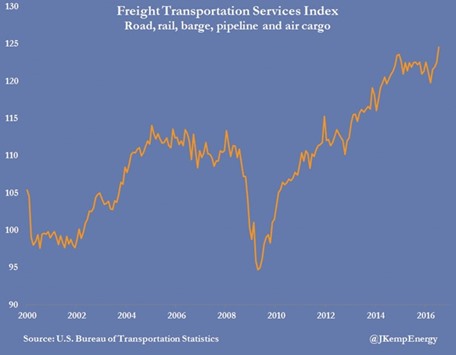Freight movements across the United States are showing signs of sustained growth for the first time in 18 months, which should support increases in diesel consumption in 2017.
Freight volumes hit a record in July, passing the previous peak set back in December 2014, according to the US Bureau of Transportation Statistics.
The Bureau’s freight transportation services index has risen for four consecutive months, after flat-lining or falling for more than a year.
The index is a composite capturing movements by truck, railroad and barge as well as air cargo and pipelines.
The four month-to-month increases between March and July were the longest series of unbroken gains since December 2014 and the fastest overall rise in any comparable period since February 2013.
The unusually large monthly gain during July was driven by sharp increases in movements by truck and train, linked to growth in oil and gas drilling, the utility sector, and manufacturing, according to BTS.
Slumping oil and gas drilling and its impact on the entire oilfield supply chain was a major reason for the downturn in freight shipments during 2014/15 (“Oil shock is hurting US economy”, Reuters, Jan 2016).
The slowdown was exacerbated by the build up of stocks of unsold raw materials and finished products across many sectors which encouraged manufacturers and retailers to cut back on new orders.
And the drop in natural gas prices encouraged a switch away from coal consumption at power plants, which hit coal deliveries.
Coal is single most important item hauled on the railroads in terms of tonnage.
But each of these factors is starting to reverse which should lead to a significant acceleration in freight volumes over the next year. Oil and gas drilling has stabilised and started to increase again, according to weekly rig counts published by oilfield services company Baker Hughes.
Manufacturers and distributors have halted the build up of excess inventories and starting to make progress working them down to a more comfortable level.
And natural gas prices have begun to rise which should result in a small increase in coal consumption at power plants in 2017.
The US Energy Information Administration predicts coal consumption at power plants will rise by 18mn short tons, or around 3%, in 2017 (“Short-Term Energy Outlook”, EIA, Sep 2016). Freight firms will continue to struggle for some months more because of the enormous amount of excess capacity within the transportation sector.
But the increase in freight, as well as oil and gas drilling activity, which relies on diesel-electric engines, as well as diesel generators for auxiliary drill site power, should boost diesel consumption significantly in 2017.
US diesel consumption is forecast to increase by 80,000 barrels per day, just over 2%, in 2017, as a result of a colder winter and freight growth, according to the EIA.
But the forecast could prove conservative if this winter proves much colder than last year’s exceptionally warm one and there is a sustained rebound in oil and gas drilling as well as freight movements.
*John Kemp is a Reuters market analyst. The views expressed are his own.



